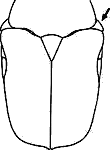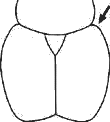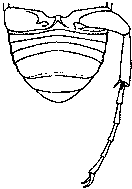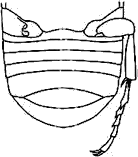| 1. . |
Posthumeral elytral emargination present; mesepimeron visible from above (fig. 1) | . 2 |
||||||
| 1'.
. |
Posthumeral elytral emargination lacking; mesepimeron not visible from above (fig. 2) | . 4 |
||||||
|
||||||||
| 2(1). | Pronotum with basomedian lobe enlarged, covering scutellum | Gymnetini |
| 2'. | Pronotum without enlarged basomedian lobe; scutellum visible | |
| 3(2). . |
Labium not enlarged or cup-shaped, less than half as wide as head | .
Cetoniini |
| 3'.
|
Labium cup-shaped, one half to three quarters as wide as head | Cremastocheilini |
| 4(1). . |
Posterior coxae contiguous or nearly so (fig. 3). Foretibia with 1-3 teeth | |||||||
| 4'. | Posterior coxae widely separated (fig. 4). Foretibia with 3-5 teeth | |||||||
|
||||||||



